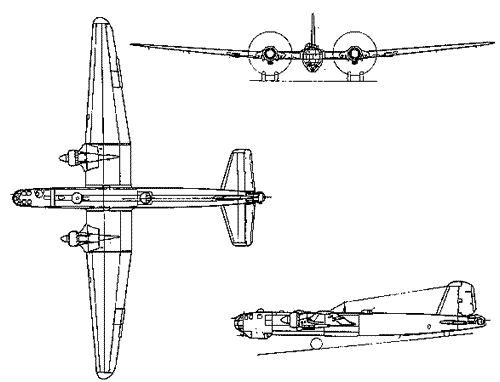|
Heinkel He 277: Nazi Germany’s Last Heavy
Bomber Design
By:
Mr. R. Colon
rcolonfrias@yahoo.com
PO Box 29754
Rio Piedras, Puerto Rico 00929

Infuriated by the early English small bombing raids over German cities in
Early 1942, Adolf Hitler, and Luftwaffe chief, Reich Marshal Hermann
Goring; decided that Germany needed an aircraft capable of striking deep
behind the enemy front line: in this case the Soviet Union and probably,
in the future; the United States mainland. Encouraged by the perceived
effect of the relative small raid carried out by Colonel Jim Doolittle
over the Japanese Home Islands in April 1942, Goring pressed the Luftwaffe
to develop a bomber capable of reaching the American coast. The idea of a
deployable long range strategic bomber was the brainchild of an obscure
German officer. Lieutenant General Walther Wever, a World War I veteran
who served on the staff of the most important German commander of the
Great War, General Erich Ludendorff. After the war, he rose steadily
through the ranks until reaching Chief of the Air General Staff in late
1932.
He quickly realized Germany’s future need for an all-metal heavy bomber
that could carry a payload of at least 3,300lb to a distance of 1,240
miles. He believed that the main target for this new bomber concept was
the vast Soviet Union, thus his idea was known in the aviation circles as
the Ural Bomber. By 1936, Wever declared in the Luftwaffe’s Annual
Training Manual, “that air power carries the war right into the heart of
the enemy”. Orders were issued in 1936 to design a long range, heavy
bomber; based on Wever’s concept. Wever himself never lived to see the
result of his work having being killed in a take-off accident on an
airfield near Dresden.
Many concepts were presented to the Luftwaffe. Companies such as the
Junkers and Messerschmitt, submitted design blue prints and mock-ups of
what they envisioned the new bomber could be. It was around 1942, that the
successful Heinkel Company presented a design for a massive heavy bomber
based on its venerable He 111 twin engine bomber that was at that time,
the backbone of the Luftwaffe Bomb Arm. With an operational range of 1,200
miles, the 111s were a common sight in the skies over Great Britain during
the German Blitz. Heinkel’s first attempt at producing a four engine
bomber, the He 177, was seen by the Luftwaffe as a major disappointment.
The 177 was basically a four engine dive bomber plane. Their crews called
it the “flaming coffin” because on dives, the engines had a tendency to
overheat, causing the aircraft to catch fire. Thus the company was
labelled as a risk factor in the designing of large bomber type.
Nevertheless, Heinkel tried to modify the 177 fleet when it unveiled the
next generation of the 177, the He 177B. The 177B upgrade program was
never authorized by the Luftwaffe’s top command, but the company, in dire
need of government contracts; needed to re-establish itself as a feasible
aircraft manufacturing concern and undertook the design with its own
resources. When the 177B concept design was completed, the company’s
founder, Heinkel, presented it directly to the Fuehrer in a March 1944
meeting near Berlin. After carefully studying the blueprints, Hitler
ordered Heinkel to commence full production of the design as soon as
possible. The gamble by Heinkel had apparently paid off.

Soon after gaining approval from Hitler, Heinkel changed the designation
of the aircraft to the He 277. Work commenced promptly on the development
of the bomber. The first example of the He 277 made its maiden flight in
mid December 1943. The test showed some minor designs flaws, and the
aircraft was grounded for the flaws to be corrected. The aircraft was
shipped out to Heinkel’s Austrian facility for refinements. The Luftwaffe
was impressed by the aircraft concept and the idea that the 277 could be
mass produced. They envisioned the first production line could be set up
by early 1944. This is as far as the program went. The continuing
deterioration of the German air situation, forced the Luftwaffe in July
1944, to transfer all aviation efforts to the development and production
of fighters in an attempt to stem the massive Allied assault on their
homeland. Records found after the Allied victory showed that up to eight
examples of the 277 were built, all of them destroyed by Allied bombing.
Just a few items remained of the 277 program.
Photos and dimension prints were captured by the advancing Anglo-American
armies in April 1945. From these few pieces, we can visualise what the He
277 was like. The records showed that two different 277 versions were
produced. The B and V series. Only the B series is well documented by the
captured German records. The B series was the bigger of the two, with a
fuselage of 73’ long and a wingspan of just over 131’. The 277B was
powered by four 213-F Jumo engines, each of them capable of producing
2,060 hp. These engines gave the He 277B an estimated maximum speed of
355mph, while the operational range was estimated to be in the 4,400 to
4,500 miles. With this range, the aircraft could, in theory, carry out
bombing raids against America’s costal cities. Unfortunately for the
Germans, time had run out, and many innovating ideas, such as the 277, the
Antipolar Bomber, and others; never made it into full production. Had the
war lasted a couple of more years, we can only imagine what these new
weapon platforms could have done.

References
Hitler’s Last Weapons, Josef Garlinski,
Magnum Books 1979
German Secret Weapons of the Second World War, Ian V Hogg, Stackpole Books
1999
Secret Weapons of World War II, William Breuer, John Wiley and Sons 2000
|
